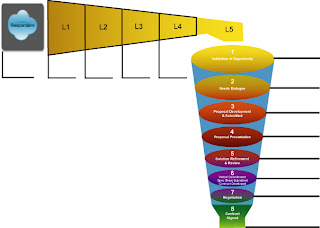Generating demand is a three-step shared ecosystem — find the leads, nurture them to opportunities, and win the opportunities. I say shared because both Sales and Marketing need to participate in all three steps – but not necessarily own each step. Let’s explore these steps in greater detail:
Step 1:
Find the leads – whether you are B-2-C or B-2-B, you need to get people interested in buying your goods and services. I think that we would generally agree that this is Marketing’s role. We could spend a lifetime discussing lead generation - but let's keep our focus on undestanding pipeline leakage points.
Step 2:
Nurture those people that are interested in your goods and services. A best-practice is to implement and follow a lead nurture process. It’s where you leverage tele response, email and other nurture tactics to engage your leads, score them based on a quality scale and convert to opportunities when they have a specific score. A best practice scoring model is to use the BanTT process. BanTT stands for budget, authority, need, time frame and trust. By using BanTT you weigh each part of the process and send the lead to Sales once it hits an agreed upon threshold – like 75 out of 100 available points. This scoring should be outlined in your SLA and the threshold score should be agreed upon. This is a major part of the SLA. It’s the quality check. If Sales agrees to follow up on all leads that score above a threshold, and then do not and complain that they are not really opportunities – Sales is in breach of the SLA and research needs to be performed to find out why.
Step 3:
Win the opportunities. For the sake of this discussion, I'm going to assume that you have a documented pipeline management process. See the attached graphic as an example.

What goes in at Stage 1 are validated opportunities and we all know the game – get them to close in revenue. Marketing should be well-versed on the process and is should also be documented in the SLA. They key to understanding these steps is to make sure you have a valid, documented and reported nurture and pipeline process.
Measure and report to ensure that you are capturing data at all steps of the ecosystem. This is vastly important – it’s how you find out about your leaks. What is a leakage point? It’s an area in your nurture phase and pipeline where deals get stuck or there is a large amount of discontinued or lost opportunities. Most leakage points occur at transition points – from marketing to the nurture phase, when marketing hands off an opportunity to sales or when sales moves an opportunity from a proposal stage to a presentation/finals stage.
Where are your leakage points? If you don’t know, I recommend that you take immediate steps to find them. When you do find them, you can then implement solutions to plug the leaks. That’s where we will continue with the next installment of this blog – fixing the leaks. Until then, always remember that sales and marketing are one continuous demand and revenue generation team.

handsome work.
ReplyDeletePile Repairs
Waterproofing